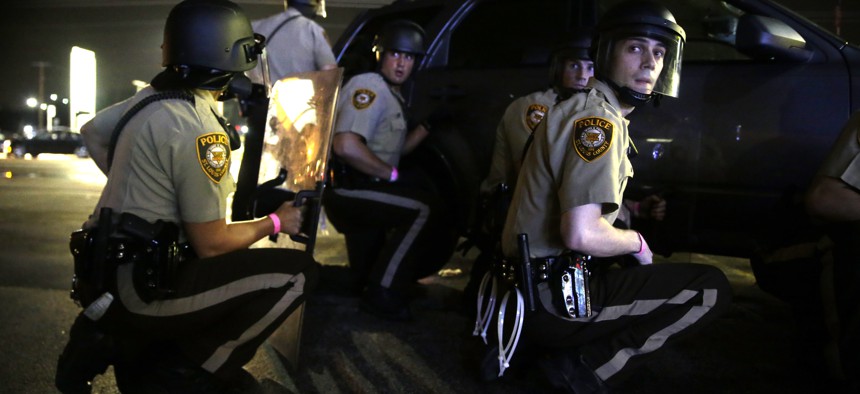
Police take cover behind a vehicle during a protest in Ferguson, Mo., Sunday, Aug. 9, 2015. AP/ JEFF ROBERSON
After Ferguson Unrest, St. Louis Police Bought Stink Weapons to Launch at Protesters
If the current situation escalates, protesters could be in for a horrible-smelling surprise.
Another year, another series of violent protests in the city of Ferguson, just outside St. Louis, Missouri. But this time, the law-enforcement response may take a particularly fetid turn. Local police are armed with Skunk, a controversial chemical “ malodorant ” — or more plainly, an unbelievably foul-smelling liquid that can be fired at protestors to make them disperse, or mark them for later arrest.
Last November, the St. Louis Metropolitan Police Department ordered fourteen 1.4-liter canisters of Skunk at a unit price of $30.60, for a total cost of $428, according to a Nov. 14 invoice obtained through the state’s open-records law . The order also included two MK-46 HE canisters , which can shower 60 ounces of Skunk on people up to 40 feet away, and five MK-20 Titan canisters, which can carry 20 ounces up to 24 feet. The department also ordered four units of special disinfectant soap for $121. A second document , dated January 12, 2015, appears to confirm delivery of the material as an “emergency purchase.”
Developed in 2008 by the Israeli Defense Forces for use against Palestinian protesters, Skunk is a mix of amino acids and baking soda. It is technically “non-toxic” but hardly humane. Once used, it can linger for weeks unless removed by the special soap. The smell has been described as a cross between feces and rotting corpse.
This SkyNews footage from 2008 documents one of the first uses of Skunk in a military setting. In the video, a Palestinian man can be heard declaring, “It makes you feel inhuman.”
In April, representatives of Mistral, a U.S. supplier of Skunk, announced at the National Defense Industrial Association’s Armament Systems Forum that it had supplied the chemical to police. “We’ve provided some Skunk for the law enforcement agencies in Ferguson. They did not use it yet but they do have it,” said Stephen Rust, general manager of Mistral. (The company also sold Skunk to police departments in Bossier City, Louisiana, Defense One has confirmed.)
At the time, officials with the Ferguson Police Department and the St. Louis County Police Department denied possession or purchase of Skunk. St. Louis Metropolitan Police Department officials, however, declined to either confirm or deny the purchase.
“We do not discuss our chemical munitions inventory,” spokeswoman Leah Freeman wrote in a May 6 email.
Defense One did not find records to indicate that the City of Ferguson itself has acquired Skunk. And the St. Louis Metropolitan Police Department doesn’t have direct jurisdiction over Ferguson, which is a separate municipality.
But Skunk could still wind up on the streets, and people, of Ferguson.
On Nov. 17, three days after the initial invoice date in the obtained documents, Missouri Gov. Jay Nixon signed Executive Order 14-14 , which allowed state, county, and municipal police to work together “to protect civil rights and ensure public safety in the City of Ferguson and the St. Louis region.” It authorized “the Missouri State Highway Patrol together with the St. Louis County Police Department and the St. Louis Metropolitan Police Department to operate as a Unified Command to protect civil rights and ensure public safety in the City of Ferguson and the St. Louis region,” Nixon said in a statement.
The order effectively put the St. Louis County Police department in charge of security in Ferguson, and allowed the St. Louis Metropolitan Police Department to help. It expired 30 days after it was issued, and was not renewed.
On Monday, the St. Louis County Police Department declared a state of emergency in the wake of protests and violence in Ferguson over the weekend. There is currently no statewide emergency that would give the St. Louis Metropolitan Police a role in the suburb.
But here’s how Skunk might come to be deployed against Ferguson protesters, at least according to the legal precedents established last year: Nixon would issue a statewide state of emergency and place the Ferguson, St. Louis County, and the St. Louis Metropolitan police departments under unified command once again. Then the St. Louis County police department, which would have “command and operational control over security in the City of Ferguson,” could order the weapon to be used.
If violence spills over in the City of St. Louis, however, the metropolitan police could use it at their discretion.





